Aman Tyagi
MatViX: Multimodal Information Extraction from Visually Rich Articles
Oct 27, 2024Abstract:Multimodal information extraction (MIE) is crucial for scientific literature, where valuable data is often spread across text, figures, and tables. In materials science, extracting structured information from research articles can accelerate the discovery of new materials. However, the multimodal nature and complex interconnections of scientific content present challenges for traditional text-based methods. We introduce \textsc{MatViX}, a benchmark consisting of $324$ full-length research articles and $1,688$ complex structured JSON files, carefully curated by domain experts. These JSON files are extracted from text, tables, and figures in full-length documents, providing a comprehensive challenge for MIE. We introduce an evaluation method to assess the accuracy of curve similarity and the alignment of hierarchical structures. Additionally, we benchmark vision-language models (VLMs) in a zero-shot manner, capable of processing long contexts and multimodal inputs, and show that using a specialized model (DePlot) can improve performance in extracting curves. Our results demonstrate significant room for improvement in current models. Our dataset and evaluation code are available\footnote{\url{https://matvix-bench.github.io/}}.
Dynamic Contexts for Generating Suggestion Questions in RAG Based Conversational Systems
Mar 18, 2024Abstract:When interacting with Retrieval-Augmented Generation (RAG)-based conversational agents, the users must carefully craft their queries to be understood correctly. Yet, understanding the system's capabilities can be challenging for the users, leading to ambiguous questions that necessitate further clarification. This work aims to bridge the gap by developing a suggestion question generator. To generate suggestion questions, our approach involves utilizing dynamic context, which includes both dynamic few-shot examples and dynamically retrieved contexts. Through experiments, we show that the dynamic contexts approach can generate better suggestion questions as compared to other prompting approaches.
Characterizing Sociolinguistic Variation in the Competing Vaccination Communities
Jul 01, 2020



Abstract:Public health practitioners and policy makers grapple with the challenge of devising effective message-based interventions for debunking public health misinformation in cyber communities. "Framing" and "personalization" of the message is one of the key features for devising a persuasive messaging strategy. For an effective health communication, it is imperative to focus on "preference-based framing" where the preferences of the target sub-community are taken into consideration. To achieve that, it is important to understand and hence characterize the target sub-communities in terms of their social interactions. In the context of health-related misinformation, vaccination remains to be the most prevalent topic of discord. Hence, in this paper, we conduct a sociolinguistic analysis of the two competing vaccination communities on Twitter: "pro-vaxxers" or individuals who believe in the effectiveness of vaccinations, and "anti-vaxxers" or individuals who are opposed to vaccinations. Our data analysis show significant linguistic variation between the two communities in terms of their usage of linguistic intensifiers, pronouns, and uncertainty words. Our network-level analysis show significant differences between the two communities in terms of their network density, echo-chamberness, and the EI index. We hypothesize that these sociolinguistic differences can be used as proxies to characterize and understand these communities to devise better message interventions.
A Computational Analysis of Polarization on Indian and Pakistani Social Media
May 20, 2020



Abstract:Between February 14, 2019 and March 4, 2019, a terrorist attack in Pulwama, Kashmir followed by retaliatory air strikes led to rising tensions between India and Pakistan, two nuclear-armed countries. In this work, we examine polarizing messaging on Twitter during these events, particularly focusing on the positions of Indian and Pakistani politicians. We use label propagation technique focused on hashtag cooccurences to find polarizing tweets and users. Our analysis reveals that politicians in the ruling political party in India (BJP) used polarized hashtags and called for escalation of conflict more so than politicians from other parties. Our work offers the first analysis of how escalating tensions between India and Pakistan manifest on Twitter and provides a framework for studying polarizing messages.
 Add to Chrome
Add to Chrome Add to Firefox
Add to Firefox Add to Edge
Add to Edge